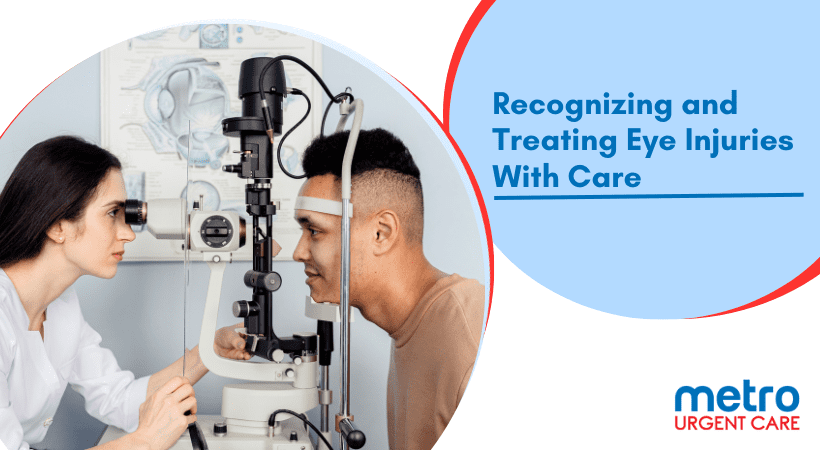


Eye injuries refer to any damage or trauma to the eyes, surrounding structures, or visual system. Sports injuries, accidents, and foreign objects in the eye can all cause eye injuries. According to research, more than 2,000 people injure their eyes at work everyday. Ignoring eye injuries can lead to various complications and long-term consequences. Serious eye injuries might result in permanent visual loss, so prompt treatment is crucial to prevent deterioration and preserve vision.
In this blog, you will learn more about eye injuries.
Eye injuries can cause various signs and symptoms, from slight pain to severe visual impairment. The following are common signs and symptoms of eye injuries:
1. Pain: Pain or discomfort in or around the eye is a common symptom of eye injuries. The intensity of pain can vary depending on the nature and severity of the injury.
2. Redness: Redness of the eye or the surrounding area may indicate irritation, inflammation, or blood vessel damage. Bloodshot eyes can result from injuries such as abrasions or blunt trauma.
3. Swelling: Swelling around the eye may occur in response to trauma or inflammation. It can affect the eyelids, the area around the eye, or both.
4. Blurred Vision: Blurred or decreased vision can be a sign of various eye injuries, including corneal abrasions, foreign object penetration, or injuries affecting the internal structures of the eye.
5. Tearing: Excessive tearing or watering of the eyes can occur due to irritants, foreign objects, or injuries. Tearing is the eye's natural response to flush out foreign particles.
6. Foreign Body Sensation: A feeling of something in the eye, often described as a foreign body sensation, can indicate the presence of debris, dust, or foreign objects in the eye.
7. Difficulty Closing the Eye: Difficulty closing the eye may occur if there is swelling, pain, or injury to the eyelids or surrounding tissues.
8. Visible Injuries: Visible injuries, such as cuts, abrasions, or puncture wounds on the eye or eyelids, may be apparent in cases of trauma or foreign object penetration.
9. Double Vision: Double vision (diplopia) can occur if the eye muscles or structures responsible for alignment are affected by injury.
10. Blood in the Eye: The presence of blood in the eye, known as hyphema, can result from severe trauma and may be a sign of potential complications.
Eye injuries can result from various causes, often occurring in everyday activities. Understanding the common causes can help individuals take preventive measures while seeking eye injury treatment. Some common causes of eye injuries include:
1. Foreign Objects: Dust, dirt, wood chips, metal shavings, or other small particles can enter the eye and cause irritation or injury.
2. Blunt Trauma: Impact from a sharp object, such as a ball, tool, or elbow, can cause contusions, fractures, or other injuries to the eye and surrounding structures.
3. Chemical Exposure: Contact with chemicals, including household cleaners, industrial solvents, or other corrosive substances, can lead to chemical burns or irritation.
4. Sharp Objects: Penetrating injuries can occur when sharp objects, like knives, scissors, or projectiles, come into contact with the eye.
5. Sports Injuries: Activities such as sports or recreational games can lead to eye injuries from high-speed projectiles, collisions, or contact with equipment.
6. Workplace Hazards: Jobs involving machinery, construction, welding, or exposure to airborne particles may pose a risk of eye injuries. Lack of proper eye protection increases the likelihood of workplace-related eye injuries.
7. Infections: Bacterial or viral infections can affect the eyes, leading to conjunctivitis, keratitis, or uveitis.
8. Car Accidents: Vehicle accidents can cause eye trauma, especially if occupants are not wearing seat belts or if there is contact with airbags.
9. Children's Play: Children may experience eye injuries during play, such as being struck by toys or accidental pokes by fingers.
10. Projectile Objects: Projectiles generated during activities like hammering, grinding, or cutting can pose a risk if proper eye protection is not used.
Minor irritation or damage to the front of the eye typically does not necessitate medical attention and resolves within 24 hours. If a person's symptoms of pain, visual disruption, odd look of the eye, or bleeding persist, they should seek immediate medical attention.
Swift action is crucial in treating eye injuries. Immediate treatment and seeking professional help can prevent severe complications. Whether it's something in the eye or contact with chemicals, each situation needs unique care. Remember, never rub or apply pressure to the injured eye. Instead, gently rinse it with clean water and cover it to protect it from further harm. Getting medical help means the injury will be checked properly and treated the right way, keeping your vision and overall eye health safe.
At Metro Urgent Care, we deliver high-quality, patient-focused, reasonably priced eye injuries treatment. With convenient locations at 5406 W. Fullerton Ave. (773) 341-2897 and 3235 W. Montrose Ave. (773) 669-0005, our expert team of doctors is ready to provide personalized solutions and support. As one of Chicago’s premier walk-in urgent care centers, we help alleviate your pain and support you in living a comfortable life! Contact us today and let our experts take you through a seamless recovery!
Source: preventblindness.org